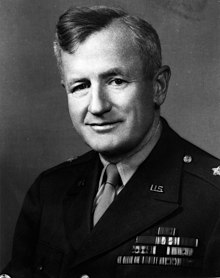Thomas Farrell | |
|---|---|
 | |
| Birth name | Thomas Francis Farrell |
| Born | 3 December 1891 Brunswick, New York, U.S. |
| Died | 11 April 1967 (aged 75) Reno, Nevada, U.S. |
| Allegiance | |
| Service | United States Army |
| Years of service | 1916–1946 1950–1952 |
| Rank | Major General |
| Service number | 0-227201 |
| Battles / wars | World War I: |
| Awards | Distinguished Service Cross Army Distinguished Service Medal Legion of Merit (2) Purple Heart Croix de guerre (France) |
| Alma mater | Rensselaer Polytechnic Institute (BS) |
| Relations | Barbara Vucanovich (daughter) Patricia Dillon Cafferata (granddaughter) Peter Farrell (great-grandson) |
Major General Thomas Francis Farrell (3 December 1891 – 11 April 1967) was the Deputy Commanding General and Chief of Field Operations of the Manhattan Project, acting as executive officer to Major General Leslie R. Groves Jr.
Farrell graduated from Rensselaer Polytechnic Institute with a degree in civil engineering in 1912. During World War I, he served with the 1st Engineers on the Western Front, and was awarded the Distinguished Service Cross and the French Croix de guerre. After the war, he was an instructor at the Engineer School, and then at the United States Military Academy at West Point. He resigned from the Regular Army in 1926 to become Commissioner of Canals and Waterway for the State of New York from 1926 to 1930, and head of construction and engineering of the New York State Department of Public Works from 1930 until 1941.
During World War II he returned to active duty as Groves' executive officer in the Operations Branch of the Construction Division under the Office of the Quartermaster General. He went to the China-Burma-India theater to help build the Ledo Road. In January 1945, Groves chose Farrell as his second-in-command of the Manhattan Project. Farrell observed the Trinity test at the Alamogordo Bombing and Gunnery Range with J. Robert Oppenheimer. In August 1945, he went to Tinian to supervise the bombing of Hiroshima and Nagasaki. Afterwards he led teams of scientists to inspect the effects of the atomic bombs.
In 1946 he was appointed chairman of the New York City Housing Authority. He subsequently worked as a consultant for the Triborough Bridge and Tunnel Authority on projects such as the Cross Bronx Expressway. He was a member of the evaluation board for Operation Crossroads, and was an advisor to Bernard Baruch, the United States representative on the United Nations Atomic Energy Commission. During the Korean War, Farrell returned to active duty once more, serving with the Defense Production Administration, and then with the Atomic Energy Commission as its Assistant General Manager for Manufacturing. He oversaw a vast increase in the Commission's production capabilities before retiring again in 1951. From 1960 to 1964, he worked on the preparations for the 1964 New York World's Fair.